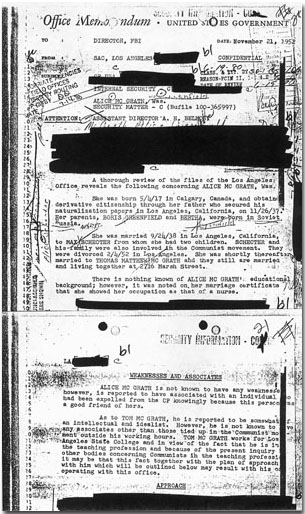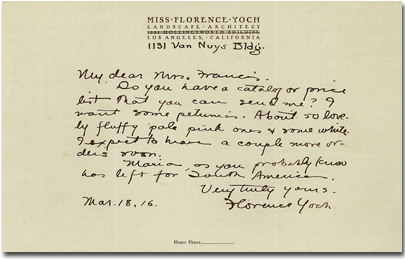
Material for the study of women is included in many sections of the Department guide and this exhibit. Holdings include personal papers and oral history interviews of and about women in a variety of walks of life.
Other sources include: the Children's Book Collection, part of which illustrates women's cultural roles and daily life; the Sadleir collection, which contains published work of many women writers in the 19th century and which continues to be supplemented with their manuscripts, letters, and diaries; and the Japanese American Research Project, which includes sociological surveys of Issei, Nisei, and Sansei women.
 |
U.S. Department of Justice. Federal Bureau of Investigation. Office memorandum [sample copy of FBI surveillance sheets of Alice McGrath, obtained through the Freedom of Information Act]. November 21, 1952. In: McGrath, Alice Greenfield, 1917 - . Papers, 1943 - 1990. Collection 1490. Box 2 f.3 In addition to these for Alice McGrath, there is a collection given by Los Angeles Communist party leader Dorothy Healey. Ms. McGrath was pleased that the FBI noted: "Subject has no known weaknesses." This is to indicate there was no way the FBI could readily "blackmail" or coerce her. But reading further in these notes, the FBI gives a way to embarrass her husband at that time, poet and educator Thomas McGrath, who was "reported to be somewhat of an intellectual and idealist." The "outline of approach" to him is blacked out by law (since not pertaining directly to Alice McGrath.) Another sheet states "In 1944 she was a member of the Sleepy Lagoon Defense Committee, a Communist front group," which it was not, although she was a communist. Alice McGrath was interviewed by the UCLA Oral History Program. |
Dorothy Healey. Dorothy Healey Remembers: A Life in the American Communist Party. By Dorothy Healey and Maurice Isserman. New York: Oxford University Press, 1990. Special Collections SRLF
 |
References |
References |  |


 Florence Yoch. Letter to Mrs. Francis [Myrtle Shepherd Francis]. Los Angeles, March 18, 1916. In: Shepherd, Theodosia Burr. Papers, ca. 1900 - 1940. Collection 123. Box 1
Florence Yoch. Letter to Mrs. Francis [Myrtle Shepherd Francis]. Los Angeles, March 18, 1916. In: Shepherd, Theodosia Burr. Papers, ca. 1900 - 1940. Collection 123. Box 1